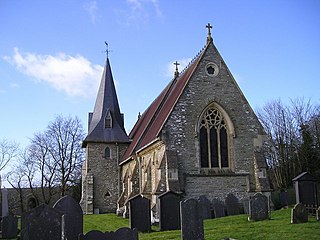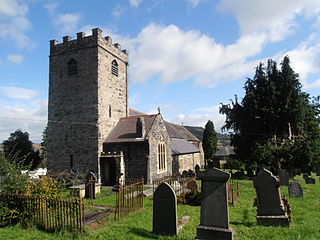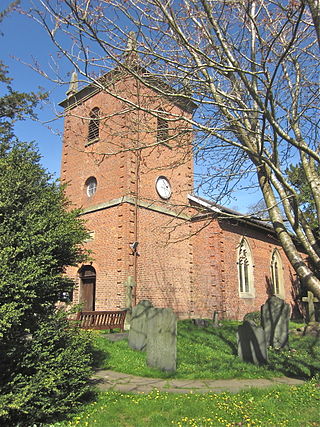Related Research Articles

Sabine Baring-Gould of Lew Trenchard in Devon, England, was an Anglican priest, hagiographer, antiquarian, novelist, folk song collector and eclectic scholar. His bibliography consists of more than 1,240 publications, though this list continues to grow.

Saint Deiniol was traditionally the first Bishop of Bangor in the Kingdom of Gwynedd, Wales. The present Bangor Cathedral, dedicated to Deiniol, is said to be on the site where his monastery stood. He is venerated in Brittany as Saint Denoual. In English and Latin his name is sometimes rendered as Daniel.

Saint Cynllo is a British saint, who lived in the late 5th and early 6th centuries, generally described as a brother of Saint Teilo. Cynllo was known for "...the sanctity of his life and the austerity of his manners."

July 4 - Eastern Orthodox Church calendar - July 6

Saint Mael and Saint Sulien's Church is a church located in the town of Corwen in Denbighshire in Wales. It was formerly located in the ancient county of Merionethshire.

Saint Beuno, sometimes anglicized as Bono, was a 7th-century Welsh abbot, confessor, and saint. Baring-Gould gives St Beuno's date of death as 21 April 640, making that date his traditional feastday. In the current Roman Catholic liturgical calendar for Wales, he is commemorated on 20 April, the 21st being designated for Saint Anselm.
Juthwara or Jutwara was a virgin and martyr from Dorset. According to her legend, she was an eighth-century Saxon, and sister to Sidwell, though some historians have theorised she was a Briton living in the sixth century. Her relics were translated to Sherborne during the reign of Ethelred the Unready. Nothing further is known with certainty about her life.

Partrishow, also known as Patricio, Patrishow, or by its Welsh names Merthyr Isw and Llanisw, is a small village and historic parish in the county of Powys, close to its border with Monmouthshire. It is in the valley of the Grwyne Fawr, in the Black Mountains of South Wales, within the Brecon Beacons National Park.
Nidan was a Welsh priest and, according to some sources, a bishop, in the 6th and 7th centuries. He is now commemorated as a saint. He was the confessor for the monastery headed by St Seiriol at Penmon, and established a church at what is now known as Llanidan, which are both places on the Welsh island of Anglesey. He is the patron saint of two churches in Anglesey: St Nidan's Church, Llanidan, built in the 19th century, and its medieval predecessor, the Old Church of St Nidan, Llanidan. Midmar Old Kirk in Aberdeenshire, Scotland, is also dedicated to him: Nidan is said to have helped to establish Christianity in that area as a companion of St Kentigern. St Nidan's, Llanidan, has a reliquary dating from the 14th or 16th century, which is said to house his relics.
Saint Cwyllog was a Christian holy woman who was active in Anglesey, Wales, in the early 6th century. The daughter, sister and niece of saints, she is said to have founded St Cwyllog's Church, Llangwyllog, in the middle of Anglesey, where a church is still dedicated to her.
Tyfrydog was a Christian from north-west Wales in the fifth or sixth century, who was later venerated as a saint. He is said to have established a church in Anglesey, and although no part of the original structure remains, the current church is still dedicated to him. A nearby standing stone is said to be the remains of a man who he punished for stealing a bible from the church.
Caffo was a sixth-century Christian in Anglesey, north Wales, who is venerated as a saint and martyr. The son of a king from northern Britain who took shelter in Anglesey, Caffo was a companion of St Cybi, and is mentioned as carrying a red-hot coal in his clothes to Cybi without his clothes getting burnt. After leaving Cybi, Caffo was killed by shepherds in the south of Anglesey, possibly acting in retaliation for insults Caffo's brother had paid to the local ruler. The area where he died has a village, Llangaffo, named after him, as well as the parish church of St Caffo, Llangaffo.

Saint Eigen, Eurgen, Eurgain or Eurgan was the legendary, and possibly historical first female Christian saint among the Britons. Her name has doubtfully been linked to two Welsh churches and is found in manuscripts from the collection of Iolo Morganwg making historical evidence of her existence dubious and limited.

Llanmerewig is a historic parish in Powys, Wales, in the historic county of Montgomeryshire, and is situated between Newtown and Welshpool. The church and small village stand on high ground, which overlooks the river Severn, and is close to Abermule; part of which lies within the parish. The river Severn forms the North Western boundary of the parish and the Eastern boundary is the river Mule, which cuts through a steep gorge, before entering the Severn at Abermule. The historic parish covered 1,023 acres.

Saint Elli was a 6th-century Welsh saint, or possibly two saints. Llanelli, a town in Carmarthenshire and Llanelly, a village in the traditional county of Brecknockshire are both named after Elli.

Saint Noyale, also known as Noaluen, was a semi-legendary 5th-century Celtic saint and virgin martyr. She is a popular saint in both Brittany and Cornwall, where she is memorialized at Newlyn East. According to legend, it is there that a fig tree growing from the south wall of the church grew from Noyale's staff. A holy well nearby was the site of her martyrdom. She was one of numerous Celtic settlers who travelled to Brittany during the Anglo-Saxon invasion of England.

Saint Aelhaiarn or Aelhaearn was a Welsh confessor and saint of the British Church. He was a disciple of Saint Beuno. His feast day was usually observed on 2 November, although it is sometimes recorded as the 1st and is no longer observed by either the Anglican or Catholic church in Wales.

A Saint Ilar is listed among the 6th-century saints of Wales and is the probable namesake of Llanilar in Ceredigion and its former hundred of Ilar. His feast day is variously given as 13, 14, or 15 January, but is no longer observed by either the Anglican or Catholic church in Wales.

St Llwchaiarn's church, Llanllwchaiarn was the parish church of Llanllwchaiarn, now within the community of Newtown with Llanllwchaiarn and lies within the historic county of Montgomeryshire in Powys. The church occupies a position on rising ground overlooking the river Severn and is to the north east of Newtown. The present church was rebuilt in 1816. In 2011 the medieval carved screen, originally from St Mary's church in Newtown, was re-positioned in Llanllwchaiarn church
References
- Baring-Gould, Sabine; Fisher, John (1907). Lives of the British Saints. Vol. 2. London: Charles J. Clark.
- Higitt, John; Forsyth, Katherine; Parsons, David N. (2001). Roman, Runes and Ogham. Donington, Lincolnshire: Shaun Tyas. ISBN 978-1-90028-944-3.
- Hooke, Della (2010). Trees in Anglo-Saxon England. Rochester, N.Y.: Boydell Press. ISBN 978-1-84383-565-3.